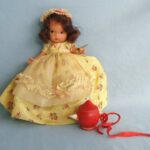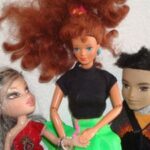In Ancient Egypt, indoor and outdoor games were at the heart of the Egyptians daily social life. Children played with dolls and home-made toys, and both young and old took part in simple ball games. Adults occupied their leisure time by playing board games, while the nobility enjoyed hunting and entertaining at lavish banquets.
Thousands of years ago, toys and games played a large part in the life of children and adults, just as they do today. The Egyptians like to amuse themselves with games that involved patience, contemplation or mere chance. Some even went as far as settling disagreements with popular board games such as senet or mehen.
Egyptian girls had dolls made of cloth, clay or wood. Sometimes they also had fetish dolls, which were believed to bring their owner a long line of descendants.
Toys in the form of animals were highly prized and many examples have been found. These include a crocodile with articulated jaws, little horses mounted on casters and pulled along with a piece of string, a mouse with a removable tail, as well as tops, rattles and puppets with moving joints.
In addition, there were toys in the form of many items from everyday life, such as horse-drawn chariots and boats. Miniature weapons were among the favorite toys for boys.
The discovery of these toys, as well as reproductions that depict various leisure activities, gives us a clear insight into the daily social life in Ancient Egypt.
Ball games delighted old and young alike. Ladies of the harem would even entertain their master with their grace and skill in handling them. The balls were made from papyrus or several cloths wound tightly together.
There were also plenty of other games requiring skill and strength, comparable to those found in our fairgrounds: target shooting, fishing with a stick, throwing sharpened objects at a wooden base (possibly an ancient form of darts). A more violent game was one in which a player would lie down and had to guess who was hitting him. In another game, a child would be shut in a hiding place from which he had to escape without being caught. Wrestling, racing and jumping were also popular.
During their social time, adults would take advantage of the open air and sunlight to sit under an arbor or in the street and play board games. Several very well-preserved examples of these have been found in tombs. At that time, it was common to take board games into your tomb for amusement in the afterlife or even to play a game with the gods.
The most popular was probably senet, which appeared at the start of the dynastic era. During the New Kingdom, Egyptian theologians gave it a religious dimension. It was even illustrated in a formula in the Book of the Dead to demonstrate that the deceased would play out his destiny in the afterlife and have to overcome all the obstacles there.
Senet is often thought to be the forerunner of our games of draughts or backgammon. It was played on a board of 30 squares (three rows of ten squares) made of terracotta, wood, ivory or alabaster.
Pieces in two colors or shapes were placed on this board. The aim was to succeed in being the first to have no pieces left on the board. Certain squares were traps, while others brought a bonus.
The Game of the Serpent or mehen is the oldest board game attested to in Ancient Egypt and was similar to snakes and ladders. It was played on a round board in the shape of a coiled serpent. Its body was divided into squares, their number varying from 30 to nearly 500 according to the size of the snake.
It was played with 36 red and white marbles, six playing pieces and sticks for throwing. In order to determine how far the pieces should move, sticks or jacks made of stone or clay were thrown, since dice would not appear until the Roman Period.
Although the scribe would proudly display the size of his stomach as proof of his success, the Egyptians still valued strength and agility.
The royal family and high ranking officials like to take part in sporting events. Among the most common were boxing, wrestling and javelin throwing. A for or martial arts took place between Egyptian soldiers and foreign warriors. For this contest, sticks were used and the participant’s heads and chins were padded with leather.
There was even something akin to the Olympic Games instituted by Ptolemy II under the name of ‘Ptolemaeia. Every four years, teams confronted one another in several disciplines, including gymnastics, swimming, weightlifting, the high jump, tug-of-war and horse riding.
We should also add the game of jacks to this list, the rules for which do not appear to have changed for thousands of years.
Whilst it was a necessity for the majority of Egyptians, hunting was a pleasant form of entertainment for the nobility. It was not so much ‘the kill’ that counted, but a good display of cunning and sportsmanship.
Accompanied by their wives and children, the nobles went to the marshes of the Faiyum or to the delta to hunt ducks and geese. When the royal family glided over the water in small boats, the birds would fly off, panic-stricken at the noise. This was the time for the hunter to show his skill by throwing a stick, rather like a boomerang, to knock out the birds. It was then the job of the servants to retrieve the catch.
Just like the pharaoh, nobles also hunted with bows. Sometimes, the servants would set up the boundaries of an enclosure beforehand to prevent to wild animals from escaping. Foxes, ostriches, hyenas, hares, antelope and other deer, all tried desperately to run from the cascade of arrows that rained down on them.
Boating was also one of the Ancient Egyptians’ favorite pastimes. Both children and adults loved going on trips in flat-bottomed papyrus boats along the Nile or in the marshes. The entire household, including the pets, would go on an outing and it was customary to take a picnic.
Father and son took the opportunity to cast a line or harpoon some fish. People of some wealth also went fishing, but often only in the pond at their villa, while enjoying a few glasses of beer or wine.
Another of the Egyptian nobility’s favorite forms of recreation was entertaining, which took the form of giving or attending magnificent banquets. While servants distributed food, flowers and perfumes, the hosts and their guests listened to singers and musicians. They ate and drank to their hearts’ content while entranced by the swaying movements of beautiful dancers.
Unfortunately, not many lyrics of songs dating from Ancient Egypt have been found, except for a few texts of love songs dating from the Ramesside period. The Egyptians generally associated music and dance with the joys of love.
There were many religious festivals in Ancient Egypt. They were not only sacred in character but also closely linked to the rhythm of the seasons under the benevolent eye of the gods. Dances and feasts accompanied these celebrations, which sometimes continued for several weeks.
The cycle of the seasons, as well as the mysteries of nature and beliefs, was also instrumental to the very functioning of society in Ancient Egypt. The year was divided up into a calendar, which consisted of three successive periods of about four months and was governed by the seasons and festivals.




